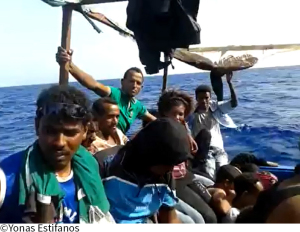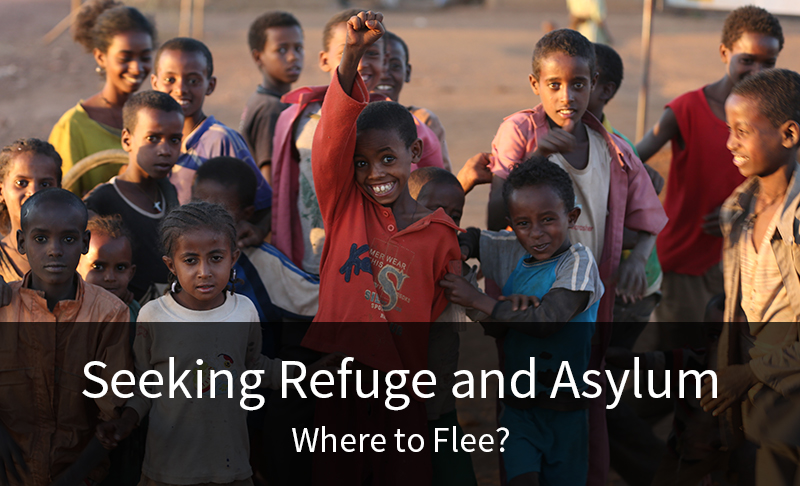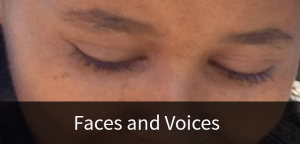Across Libya and the Mediterranean, Toward Europe
Seeking Refuge and Asylum
Across Libya and the Mediterranean, Toward Europe
Libya: Caught in the Crossfire
Since the Arab Spring, many thousands of Eritreans and other sub-Saharan Africans have sought to be smuggled through Libya and then across the Mediterranean into Europe. That process was made possible by the fall of the Qadaffi regime in 2011 and the general lawlessness in Libya that ensued. But as tribal, sectarian, political and militia violence engulfed that country, Eritrean refugees there became caught in the cross-fire. By way of example, in April 2015, a number of male Eritrean Christians (together with a group of male Ethiopian Christians) were massacred in Libya on religious grounds by ISIS — the self-proclaimed Islamic State. An accompanying group of women were taken hostage; and an accompanying group of youth underwent forced conversions to Islam. ISIS published videos of the executions on the Internet.
But not only ISIS threatened in Libya. As reported by Amnesty International in May 2015, that country’s descent into chaos made refugees and migrants from both West and East Africa targets of beatings, torture, rape, extortion, starvation, robbery, enslavement and murder at the hands of many actors, from smugglers to gangs to private businesses to militias to governmental prison authorities. The report states that sub-Saharan Africans are generally reviled by many in the country; and women, Christians, and those held in government detention centers were especially vulnerable to abuse. The Amnesty report appears here. In February 2016 an additional report on the smuggling and trafficking abuses occurring in Sudan and Libya was issued by the Intergovernmental Authority on Development (East Africa, which appears here. In June 2016, Amnesty issued an additional report detailing horrific abuses by the Libyan coast guard and in Libyan detention centers, with Christian detainees being treated most severely. The Amnesty report on detention abuses appears here. The Wall Street Journal reported in April 2017 that often, when a small boat was rescued at sea (as had become the normal course relative to the sea voyages), the rescuers learned that all of the women on board had been raped in Libya. In September 2017, UNICEF and the International Organization for Migration issued a further report, emphasizing how children and adolescents are particularly at risk for grotesque abuse in Libya, with some 83% having been abused. In December 2017, Amnesty reported on the EU’s responsibility for the atrocities being committed in Libyan government detention centers. In March 2019, the Women’s Refugee Commission elaborated on the pervasiveness and barbarity of sexual abuse, including in Libyan government detention centers. Many other reports to similar effect have been published. Since that period, those abuses have continued – often against refugees and migrants who had been intercepted at sea, under pressure and with assistance from Europe, by the Libyan coast guard and returned to detention in Libya. Amnesty reported again in July 2021. Amnesty reconfirmed the “hellish” conditions in a January 2022 report, stating that since 2017 over 82,000 people had been intercepted on the Mediterranean and returned to Libya.
As a consequence of that notoriety, reportedly far fewer Eritreans have sought to enter Libya in more recent years. But earlier arrivals remain trapped there. And others are being kidnapped and brought there by traffickers and smugglers, who reportedly have engaged in chaotic, ever-shifting and ever-ruthless business models. From 2023 through 2025, The America Team received continuous reports of rape, assault, detention, medical privation, torture and extortion for ransom on the part of smugglers, traffickers and even police — coming from victims and witnesses, and numbering in the scores or hundreds of incidents.
Remarkably, tens of thousands of those passing through Libya nevertheless have arrived in Europe, usually brutalized and traumatized. But other tens of thousands remain stranded in Libya, often imprisoned or enslaved. Other human cargo — estimates run to the thousands — have simply been left for dead in the Libyan desert.
Seeking Refuge and Asylum
The Mediterranean Crossing
 Beginning in 2013, the number of Mediterranean crossings to southern Europe (especially Italy) by migrants and refugees from many countries in Africa and the Middle East swelled dramatically, as did the number of drownings and other deaths at sea, as the smugglers’ over-crowded and un-seaworthy boats sank or otherwise failed. A December 2016 report by an EU military task force stated that the smugglers had come to tow motorless boats out to sea and set them adrift to be rescued by others, without any hope of the boats reaching their destinations on their own power. The same report stated that Al Qaeda and other radical Islamist movements were profiting from the smuggling trade along that route.
Beginning in 2013, the number of Mediterranean crossings to southern Europe (especially Italy) by migrants and refugees from many countries in Africa and the Middle East swelled dramatically, as did the number of drownings and other deaths at sea, as the smugglers’ over-crowded and un-seaworthy boats sank or otherwise failed. A December 2016 report by an EU military task force stated that the smugglers had come to tow motorless boats out to sea and set them adrift to be rescued by others, without any hope of the boats reaching their destinations on their own power. The same report stated that Al Qaeda and other radical Islamist movements were profiting from the smuggling trade along that route.
From mid-2015 through late 2016, many Eritreans chose to avoid the Libyan perils by instead sailing to Italy from Alexandria, Egypt, even though the sea voyage was protracted and thus materially more dangerous than the shorter sea route from Libya. But in late 2016 the Egyptian government began intercepting the traffic and imprisoning the smugglers and their cargo, causing that route largely to close.
The number of drownings would be far higher but for the large scale and continuous rescue missions deployed by governmental authorities and NGOs, which until mid-2017 appeared to be growing steadily. But (as described below on this page) the initial European welcome of African migrants over the years had faltered. In 2017 the NGOs came under political and legal attack by European governments and anti-immigration activists, who asserted more forcefully than before that the rescuers were complicit with the smugglers and were colluding in illegal immigration. As a consequence, several NGOs stopped their rescue missions. In September 2017 the Libyan coast guard boarded an NGO vessel, demanded the relinquishment of refugees (which the NGO refused), and subsequently threatened to halt all NGO traffic within a self-declared protected zone — thus further jeopardizing the future of the missions. By late October, only one large NGO rescue ship was still operating.
But also by late summer of 2017, paradoxically, it became apparent that Mediterranean crossings by Africans from Libya to Italy had abated materially. It was not immediately clear why. The abatement may have involved fewer would-be migrants setting out from Africa for Europe to begin with — due to the depravities in Sudan and Libya becoming better known to them (see above), the drownings becoming better known (see above), hardships in Europe (housing, employment, hostility) becoming known, or other reasons. Or it may have involved migrants setting out for Europe but not making it — due to some combination of actual drownings, the harsh European efforts to stem the flow on the Mediterranean routes (see below), and even the migrants simply disappearing into imprisonment, slavery, torture for extortion, or death once they arrived in Libya (see above). Nor was it clear whether the lull would endure.
In the years following, through 2024, the Mediterranean migrant traffic ebbed and flowed. “During that period, Tunisia became another major point of embarkation for sub-Saharan Africans, including Eritreans, crossing the Mediterranean to Europe, with voyages spiking in 2023. At that point Tunisia surpassed Libya as the biggest hub of illegal trafficking in the southern Mediterranean.”
Europe’s Response — an Early Chronology
Europe had begun its sea rescue missions only gradually.
In one well-publicized incident in October 2013, more than 300 Eritreans drowned off the coast of the Italian island of Lampedusa, causing the Italian government and the European Union to adopt new policies and operations for sea rescues. Italy then succeeded in rescuing tens of thousands of refugees at sea. But its rescue and reception resources became severely strained; and after a year Italy passed the principal rescue operation to the European Union, which funded the operation only thinly and proved less aggressive than Italy both in patrolling the waters for vessels in distress and in apprehending the smugglers; and as a consequence, drownings continued.
In the spring of 2015 the flood of refugees and other migrants swelled even further, and in April as many as 900 passengers — approximately 350 of them Eritreans — drowned south of Lampedusa when their vessel capsized as a European rescue shipped approached. That incident, coupled with a continuing in-flow of refugees and other migrants, provoked a great humanitarian outcry in Europe. But it also provoked a great policy confusion, involving the protection of migrants at sea versus the protection of European borders against undocumented migrants. Questions arose as to what measures Europe was willing or able to take to address either issue, including discussion of limiting asylum grants, conducting mass round-ups and expulsions of undocumented migrants, and destroying Mediterranean smuggling operations — which would leave Eritreans and other nationalities stranded, unwelcome and vulnerable to atrocities in Libya.
Since the middle of 2014, the plight of Eritreans and other refugees in Europe was compounded when hundreds of thousands of migrants and refugees from the Middle East — especially Syria, Afghanistan and Iraq — began traveling from Turkey to Greece then through the Balkans toward northern European countries such as Germany. This new “eastern” migration came to be even larger than the continuing central Mediterranean crossing described above; it was aided by an even more massive and lucrative smuggling operation; it appeared to be unstoppable; it caused chaos among European nations with respect to established cross-border transit protocols and inter-European burden sharing; it generated enormous consternation within the United Nations and the Western humanitarian community due to the limits of humanitarian resources; and many Europeans came to perceive it as having engendered a cultural and political crisis of existential proportions.
Indeed the migrant and refugee crisis contributed to the epochal referendum vote of the British people in June 2016 to exit the European Union, and to the stunning rise of right-wing, anti-immigrant political parties in Germany, France and Italy in 2017. As of late February 2016, in Germany almost 1200 physical attacks had been made against refugee shelters. Small groups of European vigilantes were setting out onto the Mediterranean to disrupt rescue missions.
For border countries such as Italy and Greece — from which other European countries were seen by some as not accepting their fair share of refugees — the strains were particularly acute. By the summer of 2017, after having initially welcomed the refugees and tolerated the economic migrants, the Italian government was now aggressively moving in the other direction: collaborating with the Libyan coast guard in interdicting smugglers’ sea-craft, such that the passengers were being sent back to Libya to be detained and from there brutalized; paying-off Libyan militias to keep migrants and refugees from even attempting the Mediterranean passage, thus likely funding some of the very Libyan actors who had been been profiting from and committing atrocities in connection with the smuggling operations; and seizing at least one NGO rescue ship — all possibly contributing to the precipitous decline of African arrivals in Italy as of late summer 2017. A December 2017 Amnesty International Report explicitly charged Italy and Europe with complicity in the widespread atrocities — squalid imprisonment, enslavement, extortion, rape and torture — that were being inflicted upon tens of thousands of trapped African migrants by the Libyan government, militias and smugglers. That report and condemnation shortly followed a similar report and condemnation by the United Nations High Commissioner for Human Rights. A follow-on Report by Amnesty in August 2018 condemned Italy for an escalation of its anti-migration efforts: forbidding migrants from disembarking on its shores, impounding NGO rescue vessels, and otherwise discouraging NGO rescue missions — all while bolstering its support for the Libyan coast guard’s operations in preventing departures from Libya, intercepting migrants on the high seas, and sending intercepted migrants to abominable abuses in Libyan detention. In late November of 2018, under pressure from the Italian government, the last of the NGO rescue operations ended. In May of 2019, the Italian government announced plans to fine NGOs 5500 Euros for each person that they might rescue at sea and bring to Italy. From January to mid-May of 2019, as a consequence of European enforcement efforts, one in four migrants who tried to reach European shores died at sea. In January of 2020, new reports appeared to the effect that European funding — intended to stanch the flow of migrants — was being used to enslave and abuse construction workers in Eritrea and detained migrants in Libya.
By late 2018, although the refugee flow had materially abated, migration issues continued to dominate political and cultural discourse within Europe. European countries remained at odds with one another as to who should accept how many migrants and at whose expense. Countries such as Hungary had come to be harshly anti-migrant; and even mainstream factions within liberal Germany now sought to limit migrant inflows. Controversial agreements had been struck with Niger, Sudan and Turkey to keep refugees out of Europe. Europe continued to struggle with processing (and then either absorbing or deporting) the 1.8 million migrants who had already arrived by sea since since 2014 — including tens of thousands of migrants who continued to live in squalor in Greece and at risk of exploitation in Italy.
The Mediterranean crossings nevertheless continued through 2024, as did overall European efforts to stymie them. Plans to interdict the flow and to repatriate the migrants came and went. Anti-immigration political voices advanced dramatically. Right-wing parties came to control or to materially influence the governments of many western and central European countries, to a great extent on the strength of their anti-immigration doctrines.
The Impact for Eritreans
All of this, of course, has had implications for the civil and legal reception of Eritreans in Europe. By way of example, both Denmark and Britain revised their policies relative to Eritrean asylum seekers so as to deny many asylum claims, pursuant to those two countries’ new and more positive characterizations of Eritrean country conditions — characterizations that were then widely discredited by human rights and refugee organizations. (The Danish investigators who had written the report resigned in disgust over its abuse. And a British administrative appeals court formally rejected the new British policy, whereupon the British Home Office undertook to revise it.) Switzerland too has made its asylum requirements for Eritreans more restrictive.
Beginning in 2022, the British government proposed to send African asylum seekers to Rwanda for processing. In 2024, a Swiss parliamentary committee proposed the same, specifically with respect to Eritreans, and it pressed Eritrea to accept several hundred Eritreans who had lost their asylum claims. Also in 2024, the Italian government arranged to send asylum seekers to Albania to await adjudication of their claims in Italy. All of those plans generated controversy.
The European Union itself has been in the middle of the imbroglio. For example, n June 2016, the EU — after having earlier in the year agreed to provide the Eritrean regime with over $200 million in general development funding so as to mitigate perceived economic causes of the population outflow — announced a plan to provide that regime with funding to help prevent Eritreans from escaping their country. Similarly, the EU funded and encouraged Sudanese border security measures, which may have contributed to the increase in Sudan’s arrest and refoulement of Eritreans in 2017. A February 2017 report by Medecins Sans Frontieres (Doctors Without Borders) tracks the plight of Eritrean refugees — from the intolerable repression within Eritrea, to the horrors of crossing Libya and the Mediterranean, to the current European attempts to push them back into Libya where further atrocities await them.
Unaccompanied Children
Of special concern to refugee advocates is the fact that some thousands of those abused in Libya and crossing from North Africa to Italy in recent years have been unaccompanied children. A February 2017 report by UNICEF details their ordeals. Eritreans comprised the largest portion of this group, with 3,092 unaccompanied Eritrean children having been registered by Italian authorities upon arrival in 2015 alone. Promptly after arrival, the Eritrean children typically were seeking to make their way from Italy to northern Europe, where they hoped to join family and friends and to enjoy generally better prospects for economic and social absorption. As a final, ironic and somber note, thousands of African child migrants — including Eritreans — were feared to have been trafficked into forced labor and sexual exploitation within Europe, often beginning in Sicily as they set out on their journeys north. The disturbing circumstances of unaccompanied refugee children (including Eritrean children) in Europe generally and in Italy specifically were reported upon by The New York Times, The Wall Street Journal, and The Guardian in the summer of 2016.



